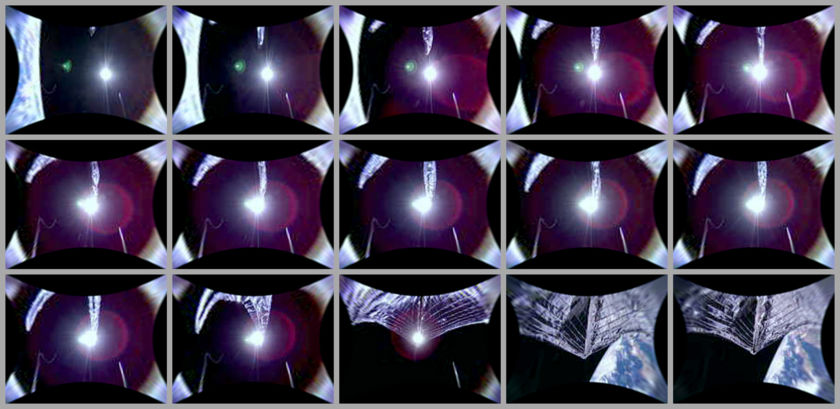
This sequence of thumbnails is from camera 1 on the LightSail 2 spacecraft. The first 13 images were taken 10 seconds apart, the final ones 30 seconds apart. Image Credit: The Planetary Society.
So. Much. Good. Stuff! Let’s get right to it then…
Bright Fireball Explodes Over Ontario, Meteorite Fragments Might Have Reached the Ground
Matt Williams | Universe Today
On Wednesday, July 24th, the people of the Great Lakes region were treated to a spectacular sight when a meteor streaked across the sky. The resulting fireball was observed by many onlookers, as well as the University of Western Ontario’s All-Sky Camera Network. This array runs across southern Ontario and Quebec and is maintained in collaboration with NASA’s Meteoroid Environment Office (MEO) at the…
Snowball Exoplanets Might Be Better for Life Than We Thought
Evan Gough | Universe Today
When astronomers discover a new exoplanet, one of the first considerations is if the planet is in the habitable zone, or outside of it. That label largely depends on whether or not the temperature of the planet allows liquid water. But of course it’s not that simple. A new study suggests that frozen, icy worlds with completely frozen oceans could actually have livable land areas that remain habitable.
The new study was published in the AGU’s Journal of Geophysical Research: Planets. It focuses on how CO2 cycles through a planet and how it affects the planet’s temperature. The title is…
All Life on Earth is Made up of the Same 20 Amino Acids. Scientist Now Think They Know Why
Matt Williams | Universe Today
The question of how life on Earth first emerged is one that humans have been asking themselves since time immemorial. While scientists are relatively confident about when it happened, there has been no definitive answer as to why it did. How did amino acids, the chemical building blocks of life, come together roughly four billion years ago to create the first protein molecules?
While that question is still unanswered, scientists are making new discoveries that could help narrow it down. For instance, a team of researchers from the Georgia Institute of Technology’s Center for Chemical Evolution (CCT) recently conducted a study that showed how some of the earliest predecessors of the protein molecule may have spontaneously linked up to form…
The Light Sail is Working… It’s Working!
Evan Gough | Universe Today
Good news from The Planetary Society: LightSail 2’s solar sail is functioning as intended. After launching on June 25th, then deploying its solar sail system on July 23rd, mission managers have been working with the solar sail to optimize they way LightSail 2 orients itself towards the Sun. Now The Planetary Society reports that the spacecraft has used its solar sail to…
How Habitable is Titan? NASA is Sending the Titan Dragonfly Helicopter to Find Out
Fraser Cain | Universe Today
There are few places in the Solar System which are as fascinating as Saturn’s moon Titan. It’s a world with a thicker atmosphere than Earth. Where it’s so cold that it rains ammonia, forming lakes, rivers and seas. Where water ice forms mountains.
Like Europa and Encleadus, Titan could have an interior ocean of liquid water too, a place where there might be life.
Titan’s got layers, and fortunately, there’s an awesome new mission in the works to explore it…
Fast Radio Bursts: Enigmatic Signals from Across the Universe
Richard M. Lawn | SETI@Home
Astronomers thrive on the appearance of new phenomenon that can stimulate novel theoretical explanations. This often results from the development of an advanced instrument that permits observations that are more sensitive than previous ones, allow us to probe a new time scale, or allow us to see the universe in a new part of the electromagnetic spectrum. But novel discoveries can also come from careful analysis of data already collected by our eyes and ears on the cosmos. SETI efforts, for example, thrive on new ways to find possible signals in the sea of data that you help analyze via SETI@home. In past decades, transient energy bursts at a variety of frequencies have yielded…
Spacetime Analogies
Gianluigi Filippelli | Doc Madhattan
The elastic sheet model is one of the most used model for telling general relativity. It allows to show as smaller balls “orbit” around the larger ball in the center of the sheet in a way similar to the planets, at least until the balls lose energy due to friction and finally fall into the “gravitational wall”.
This way to see the general relativity is directly connected with the embedded diagrams and Flamm paraboloids, the mathematical way to see the spacetime deformations. But this analogy has some problems not only because is inaccurate like all analogies, but also because…
US Military Will Use Big Brother Monitoring Technology to Track All Movement in the USA
Brian Wang | Next Big Future
US military will use Big Brother technology to track all movement in the US from blimps and from space with Synthetic Aperture Radar and high resolution cameras.
SpaceX Ridesharing Is Half the Price to Sun Synchronous Orbit for Small Satellites
Brian Wang | Next Big Future
SpaceX ridesharing Falcon rockets will drop the price for small satellites to sun synchronous orbit to half the price of competition.
SpaceX Progresses to Completing Orbital Starship by End of August
Brian Wang | Next Big Future
SpaceX progressing to completing orbital prototype versions with 3 Raptor engines each of the Starship by the end of August.
That’s a wrap! Watch for the next Carnival of Space over at CosmoQuest!





































